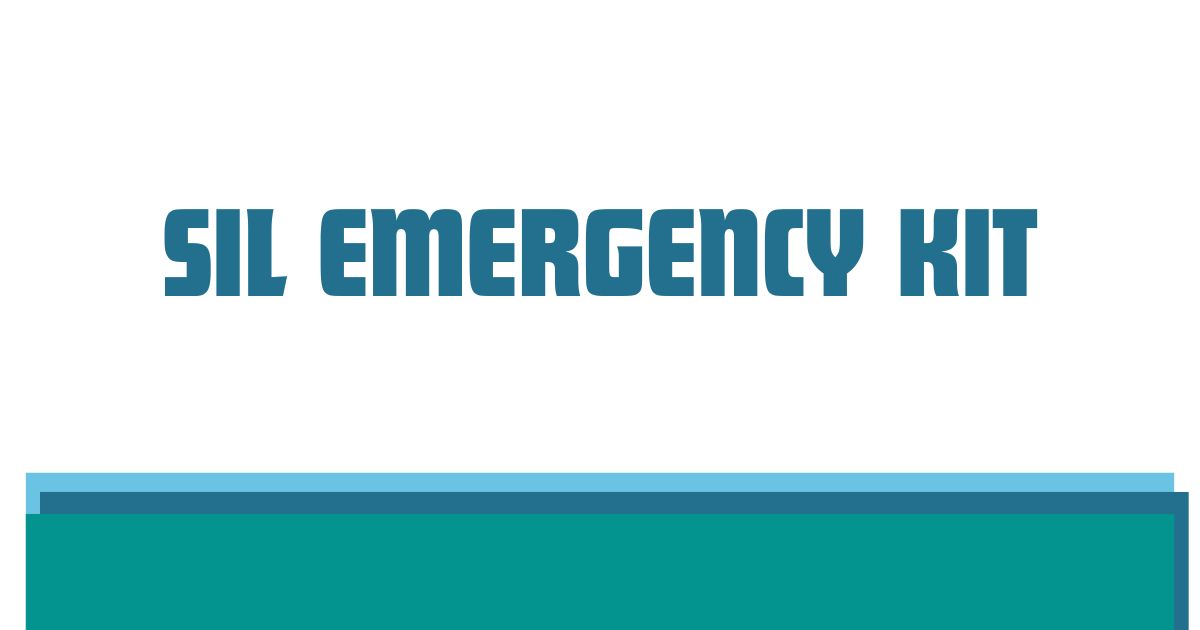An SIL emergency kit, short for Shelter-In-Location emergency kit, is a vital survival resource designed to help individuals and families stay safe and self-sufficient during unexpected emergencies like natural disasters, power outages, or civil unrest. It’s more than just a box of supplies—it’s your lifeline when the unexpected strikes. With increasing unpredictability in today’s world, a well-prepared kit isn’t a luxury, it’s a necessity.
Why You Need an Emergency Kit at Home
Emergencies rarely give us a warning. Whether it’s an earthquake, flood, or extended blackout, having an emergency kit means you can respond immediately without scrambling for resources. Your SIL emergency kit keeps you fed, hydrated, warm, and informed when regular services are down.
The Core Components of a SIL Emergency Kit
Every SIL emergency kit must cover the basics of survival: food, water, shelter, warmth, hygiene, communication tools, and basic medical care. The goal is to support survival for 72 hours or more until help arrives or services return.
Non-Perishable Food Supplies
When planning your kit, opt for calorie-dense, long-lasting foods like canned beans, freeze-dried meals, peanut butter, granola bars, and vacuum-sealed snacks. Make sure to include a manual can opener, as you won’t want to rely on electric appliances during a blackout.
Water and Purification Methods
Water is crucial, and you should stock at least one gallon per person per day for drinking and sanitation. Add water purification tablets, portable filters like LifeStraw, and collapsible water containers to extend your supply if access to clean water becomes limited.
Medical Supplies and First Aid
Accidents are common in crisis situations. Your SIL emergency kit should contain a comprehensive first-aid kit with adhesive bandages, antiseptic wipes, gauze, medical tape, tweezers, scissors, pain relievers, antihistamines, and any personal prescription medications.
Warmth and Shelter Options
If heating fails, staying warm becomes a priority. Include emergency blankets (Mylar), thermal sleeping bags, extra socks, gloves, and compact tents or tarps. Hand warmers and body heat reflectors can also help in cold environments.
Communication and Power Sources
Being informed during a disaster can be lifesaving. Include a hand-crank or solar-powered radio, power banks, and flashlight with extra batteries. A whistle can help you alert others to your location if you’re trapped or need help.
Essential Hygiene and Sanitation Items
Good hygiene prevents disease in survival situations. Pack wet wipes, hand sanitizer, biodegradable soap, toothbrush, toothpaste, toilet paper, feminine hygiene products, and sealable plastic bags for waste disposal.
Multi-Tool and Basic Survival Gear
A good multi-tool is worth its weight in gold during an emergency. It can function as a knife, screwdriver, can opener, or pliers. Also consider adding duct tape, zip ties, a small hatchet, rope or paracord, and a fire starter.
Emergency Documents and Identification
Make photocopies of your ID, medical records, insurance papers, and emergency contact numbers. Keep these in a waterproof pouch inside your SIL emergency kit. It helps in situations involving evacuation, insurance claims, or identity verification.
Cash and Backup Payment Methods
In a tech outage, digital transactions may fail. Always include some cash in small denominations and maybe a prepaid debit card. This could help buy supplies or pay for transportation in an emergency.
Clothing and Footwear
Pack a change of clothes including weather-appropriate items like a waterproof jacket, thermal layers, underwear, and sturdy shoes. Emergencies often mean walking or exposure to elements, so comfort and durability are key.
Pet Supplies for Animal Owners
Don’t forget your furry friends. Pack pet food, collapsible bowls, leashes, and waste disposal bags. Animals are family, and their survival also depends on your preparedness.
Mental Health and Entertainment
Emergencies are stressful. Pack a small notebook, pen, puzzle book, playing cards, or a favorite paperback. These items can help reduce anxiety and offer a moment of normalcy amidst chaos.
Storage and Accessibility of Your Kit
Store your SIL emergency kit in an easily accessible location known to all family members. Backpacks or plastic storage bins work great. Keep it away from moisture and heat, and check it every six months to replace expired items.
Customizing Kits for Different Needs
A one-size-fits-all approach doesn’t work. Customize your kit for children, elderly family members, or anyone with special medical conditions. Include baby formula, adult diapers, mobility aids, or special dietary items as needed.
Emergency Plan and Practice
Having the kit is one part, knowing how to use it is another. Develop an emergency plan with your family, including escape routes, meeting points, and emergency contacts. Conduct drills to practice using the kit in real-time scenarios.
Where to Buy or Build Your Own
You can purchase pre-assembled SIL emergency kits online or at outdoor stores. However, building your own allows customization. DIY kits are often more cost-effective and better tailored to your specific needs.
Review and Maintenance of Emergency Kit
Check your kit every six months. Rotate food, update personal documents, test electronics, and ensure batteries haven’t corroded. Emergencies are unpredictable, but your preparation shouldn’t be.
Conclusion
An SIL emergency kit is a practical, potentially life-saving investment in your safety and peace of mind. Think of it as your safety net—a compact, mobile command center ready to support you when the world outside isn’t. It’s not about paranoia; it’s about preparation. Life throws curveballs, and your SIL kit makes sure you’re ready to catch them.
FAQs
How often should I update my SIL emergency kit?
Every six months is ideal. Rotate food, check batteries, and update medical or personal documents.
Can I use a regular backpack for my emergency kit?
Absolutely. A sturdy backpack works well for mobility, but waterproof bins are better for stationary home storage.
What should be included for infants in an emergency kit?
Include formula, baby food, diapers, wipes, baby blanket, and infant medicine if required.
How many days should my emergency kit cover?
Aim for at least 72 hours of supplies, though prepping for 5–7 days is more ideal in extended crises.
Is it better to buy or build an SIL emergency kit?
Building your own allows for personalization and is often more affordable, but pre-made kits offer convenience.











